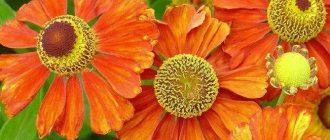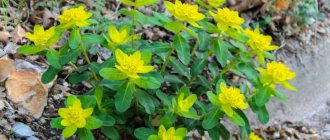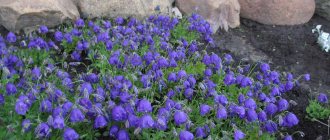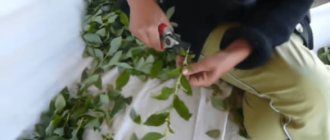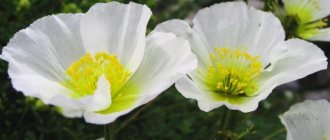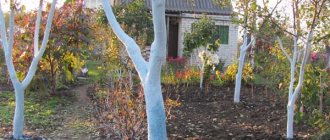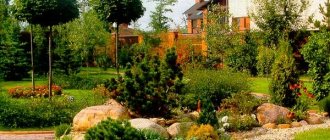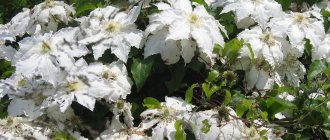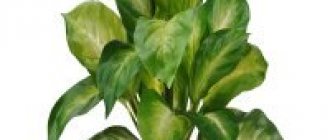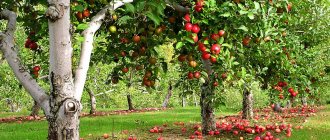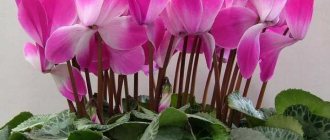Perennial oriental poppy: plant description
This type of poppy is also called low-leaved poppy and is a rhizomatous, perennial, herbaceous plant. It grows wild on mountain slopes in Turkey and Iran, the Caucasus, and can also grow in dry subalpine meadows. The bushes have impressive dimensions; their height can reach about 90 cm.
The stem, which is a peduncle, can be erect or somewhat curved, it can be covered with small leaves, or it happens that it is completely bare. The lower part of the stem is usually covered with whitish hairs.
The bushes are distinguished by powerful roots, which allow them to stay firmly in the soil and provide the flower with nutrients and moisture.
The basal leaves of the plant are lanceolate, oblong in shape with pinnately dissected edges. Their color is light green, the surface is covered with a whitish edge. The leaves on the stems have identical color and shape, only their sizes are much smaller.
During the flowering period, the plant is decorated with single flowers, their diameter can vary from 10 to 20 cm. Each flower has from 4 to 6 petals, quite large, painted in different shades of red, orange-red or rose-red. The petals of some species have a black spot at the base of the flower. The stamens and anthers are elongated and black or dark purple in color.
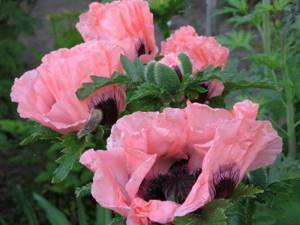
The lifespan of a flower under favorable weather conditions is about a week; flowering begins, depending on the climate zone, from the beginning of June and can last until mid-July.
The fruits of perennial poppy are very small, dark gray or brown grains, enclosed in an oblong brown or gray-green rounded box.
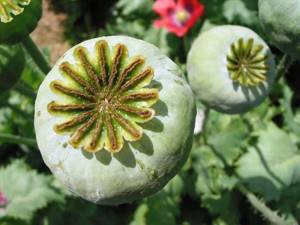
From above it is covered with a flat bottom. Each of them contains about 9 thousand seeds, their maturity occurs in August.
Classification of popular perennial poppy species
Among the most common poppies, which can grow for more than one year, there are 4 main varieties:
- eastern (aka Turkish);
- Alpine;
- holostem (saffron);
- rock-climbing (Spanish).
Oriental or Turkish (Papaver orientale)
Shrub rose in a pot - can it be grown at home?
Oriental poppy is the most famous variety of this plant and the most decorative. Most garden varieties are bred on the basis of Turkish papaver. This species is native to the mountainous areas of Iran and Turkey. In the wild it is also found on the rocky slopes of the Caucasus Mountains.
The root system of this species is powerful enough to draw moisture from the deep layers of the soil during dry periods, and also to stay firmly on mountain slopes. The height of the plant reaches 100 cm.
The leaves are collected in a basal rosette. The leaf blade itself, up to 30 cm long, is light green, with a hard edge, pinnately dissected. The petiole length of the leaf is 4-6 cm. Smaller pinnately dissected leaves may be located on the flower stems.
The flowers are large, up to 20 cm in diameter, open cup-shaped. There are 4 to 6 petals, they are round and whole. Stamens and anthers are purple or black. The petals themselves in their natural form are colored in different shades of red. There may be a dark spot at the base of the petal.
For your information! Eastern papaver blooms in early June. Flowering lasts 6-8 weeks. One flower lasts up to 5 days.
The dark gray seeds are collected in a brown or gray-green obovate capsule crowned with a convex disk. Poppy grains fully ripen in the 2nd ten days of August.
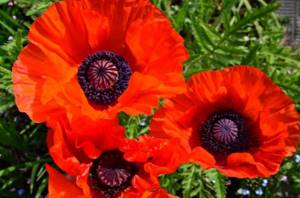
Papaver orientale
Today, gardeners around the world are pleased with more than 200 ornamental varieties of Turkish poppy, including double (peony) varieties.
Alpine (Papaver alpinum)
A medium-sized perennial, not exceeding 50 cm in height. The foliage is collected in a basal rosette. The leaf blade is narrow, pinnately dissected, green with bluish tints.
Small, up to 5 cm in diameter, single five-petal flowers are located on straight pubescent peduncles. Alpine papaver petals can be of different colors: white, yellow, red or pink. New hybrid varieties have cream or orange petals. The stamens are bright yellow. The flowers have a pleasant aroma.
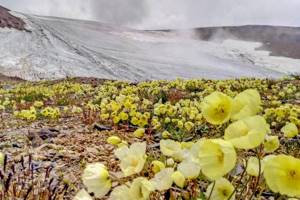
Alpine poppies in Altai
Hollow poppy (Papaver nudicaule), or saffron poppy (Papaver croceum)
Another name is saffron poppy. In cultivation it can grow as a biennial plant. In nature, it grows as a perennial on rocky slopes, in the steppes of distant Altai, Eastern Siberia, Mongolia, China and Kazakhstan. It is also found in Alaska and the Arctic regions of the Yukon.
The plant is short, from 25 to 50 cm. Green foliage with a bluish tint is collected in a basal rosette. The oblong leaf blade of the holostem poppy is pinnately dissected, with a slight edge.
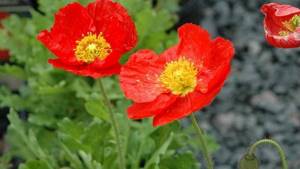
Papaver holostem (saffron)
Five-petal flowers up to 6 cm in diameter are located on straight pubescent peduncles. The flowering period covers the first two summer months. The stamens are yellow. The petal color of wild varieties is white, orange or yellow. Holostem garden poppy flowers can be peach or pink, reaching a size of 20 cm.
Rock poppy (Papaver rupifragum), or Spanish poppy (Spanish Poppy)
This plant grows in the Caucasus mountains and Asia Minor. Whole poppy fields are found in Spain. This biennial reaches 45 cm in height.
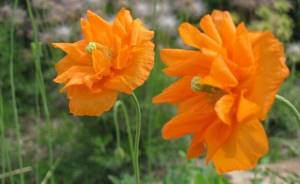
poppy
Semi-double flowers appear in the 2nd year of life at the end of May. The diameter of the flowers is up to 2.5 cm. The color of the petals is orange-red. The leaves are pinnately dissected, silver-green in color. Basal rosette. Blooms profusely throughout the summer.
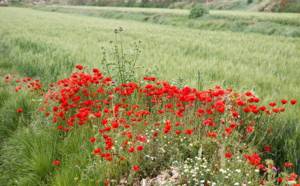
Field poppies in Spain
Types of poppy and its varieties
There are a huge variety of oriental poppy varieties, more than two hundred; breeders have worked hard to create luxurious varieties of this wonderful flower.
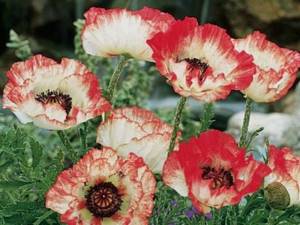
Garden forms amaze the imagination with the exquisite colors of the petals, from white to purple and lilac, from pink and orange to bright scarlet, in large sizes. Flowers may have smooth, serrated or double petals.
Most varieties of perennial poppy are hybrids.
Among the most popular I would like to note:
- Gardeners' favorite, Mrs. Perry's poppy
- amazing May Queen
- chocolate red Indian chief
- amazing white-flowered variety Perry's White.
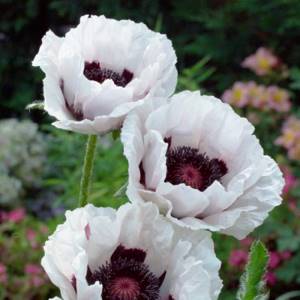
They all look great in flower beds and mixborders when planted in groups.
Where to buy and how to plant perennial garden poppy
You can buy garden poppy seedlings from amateur flower growers on the market; they are sold by garden centers and online stores. If you wish, you can purchase not seedlings, but poppy seeds and grow it yourself.
The plant is not particularly demanding of care and is not afraid of low temperatures.
It is recommended to choose areas for planting perennial poppies that are well lit by the sun, but you can get lush flowering by planting in a slightly shaded area. But when choosing a location, you should take into account that flowers look most advantageous against a background of greenery in brightly lit meadows.
The plant does not really like transplanting, so it is advisable to immediately choose a site where the bushes will grow for many years. An excellent option would be a plot on a small hill - poppies do not like lowlands, constant dampness and stagnant groundwater. If the site is located in a lowland, then you will need to take care of arranging a drainage layer.
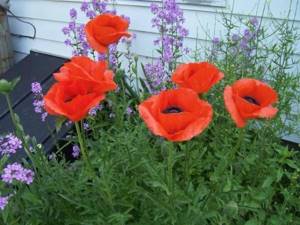
Since the flower stalks are quite tall, you should think in advance about installing supports for tying them - this will prevent the flowers from breaking off in strong winds.
Although the oriental poppy will survive in any permeable soil, it, like other plants, will look more attractive when planted in fertile, loose soil.
The application of fertilizers is encouraged, the greenery of the leaves will become brighter, the flowers will be larger. It is advisable to fertilize throughout the entire growing season. The optimal growing period in the same area is from 5 to 7 years, then the plants will need to be transplanted to another place.
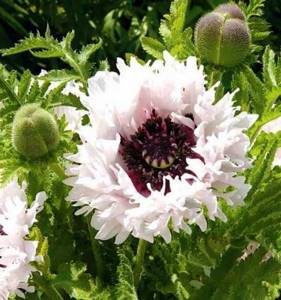
Given the tendency to grow, dense plantings should not be done; it is best to plant bushes at a distance of 55-70 cm from each other.
Let's watch an interesting video about perennial poppy and its cultivation:
Growing perennial and biennial poppies
Sowing seeds of perennial and biennial poppies is similar and not complicated. These poppies are grown:
- sowing in early spring;
- sowing before winter.
The latter option is considered preferable, since the plants are stronger and more powerful, develop better and bloom earlier. When sowing in spring, young plants will need more careful care, because while the seedlings are getting stronger, they will already face heat and drought and will not be able to develop normally without watering.
Perennial or biennial poppies can be sown in seedling beds, diving after the appearance of the first or second true leaf to a permanent place, but it is better to sow them immediately at the place of cultivation.
During pre-winter planting, the sowing of poppies is delayed until the last minute so that the seeds, which germinate quickly enough even in cold soil, do not wake up before the beginning of winter. Even a soil temperature of 3-5 degrees is not suitable: poppy is sown when the soil has time to freeze in the top layer, that is, most often in November.
In the spring, planting is carried out when the weather permits, the snow has melted and the soil has at least slightly thawed.
The technique for sowing poppy seeds remains the same regardless of the timing of their sowing:
- The soil is prepared in advance or before planting by digging and loosening the soil. When cultivating the soil, it is necessary to remove weed rhizomes, apply organic fertilizers and a complete mineral mixture (about 10 kg of organic matter, compost or humus and 40-50 g of mineral fertilizers per square meter of soil).
- At the sowing site in the fall, shallow grooves or rows are carefully created, only up to 2–3 cm deep. Spring sowing can be carried out both in furrows and superficially.
- Poppy seeds are placed at a considerable distance from each other (from 5 to 20 cm) so that the plants do not need to be thinned.
- The winter crops are covered with soil from above, making sure that they do not go too deep. When sowing in spring, the seeds are not covered or covered with a light layer of soil or film to speed up germination and the procedure is completed with watering.
- After spring sowing, you need to maintain stable soil moisture for 2 weeks and make sure to remove the film immediately when seedlings appear.
Seeds sown in the fall will germinate in the spring, as soon as the soil warms up to 3-5 degrees; spring sowing can be expected in 10-20 days. Even young plants are frost-resistant, but if frost exceeds 5 degrees below zero, then it is better to additionally protect spring crops with non-woven materials.
If sowing was carried out densely, then the seedlings are thinned out twice - first at a distance of 10 cm between plants, and then at a distance of 20 cm.
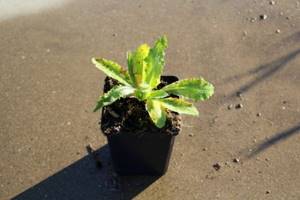
Perennial poppy seedlings. © directplant
Rules of care and watering
We have already mentioned that poppy does not like high humidity, however, the plant needs watering. Although the need for moisture is partially provided by the long root, which goes quite deep into the ground.
The plant is classified as heat-loving, although it can withstand frosts within - 35 C without any shelter.
Transfer
You should not replant the plant frequently.
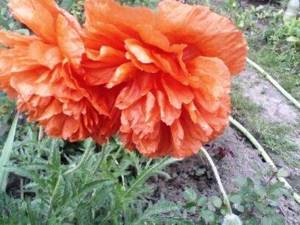
The bushes are replanted after flowering, in the fall. Since the root of the plant is very long, you will need to dig it out carefully, trying not to disturb the earth ball.
When to prune
Time is devoted to this procedure after flowering has ended. Cut off the stems and leaves at the root, because after flowering they turn yellow and wither, the plant loses its decorative appearance. After some time, young leaves appear above the ground, but their sizes will be much smaller.
They resort to complete pruning if there is no desire to collect the seeds, but if the seeds are collected, then pruning is done only after the crowns have ripened.
Alternative methods for propagating poppies
All poppies, both annual and perennial, self-sow, and this ability can be used for “improvisation”, creating natural accents and unexpected flowering spots. If you don’t want poppies to appear in unexpected places and “migrate” around the garden, or you simply want to limit the amount of self-seeding in annual poppies that are very generous in this regard, then you need to remove the seed pods before they ripen and scatter the seeds, which scatter amazingly easily from the holes under the disc at the top of the fruit.
You can often see information that poppies are divided and rejuvenated, and for perennial species it is even recommended to dig up and divide plants once every 3 years. But replanting poppies is very poorly tolerated and can only be done in exceptional cases when the plants are in danger of dying. This is not about true separation, but about the separation of lateral rosettes and shoots that appear not only in spring, but also at the end of summer. Such babies take a very long time to take root and it is difficult, but this is still an acceptable method of reproduction.
Today, more and more people are deciding to propagate poppies using green and root cuttings; root sections are found on sale along with seed packets and in botanical gardens. Root cuttings are cut from taproots, dividing them into pieces 4-5 cm long and at least 5 mm thick. After treating the cuts with crushed coal, they are dried, and then the cuttings are planted, leaving 1/3 above the soil for rooting. Under a cover, with stable humidity, the plants quickly produce tiny rosettes. After rooting and sprouts appear, the cuttings can be transplanted to a permanent location. Green cuttings are cut from lateral, weak shoots that develop on plants at the end of summer. They are rooted under a hood in a constantly moist substrate.
botanichka.ru
Pests and diseases
Of the insects, only aphids can attack poppy.
But there are quite a few diseases that can affect a plant:
- powdery mildew
- root rot
- black fungal spot
The cause of the disease is often improper care, especially frequent heavy watering.
Detected diseased leaves and parts of roots are immediately cut off and disposed of, to stop the development of the disease, the plants are treated with fungicides, Bordeaux mixture or copper sulfate solution.
Let's watch a video about growing perennial poppy:
Propagation options for perennial poppy
You can propagate poppies:
- cuttings;
- dividing bushes;
- sowing seeds.
The easiest way to grow poppies is from seeds.
Sowing is done either with the onset of spring, or before the onset of frost in the fall. Stronger plants can be obtained if the seeds undergo stratification. For autumn sowing, days are chosen at the end of November, when the temperature does not rise above + 3 +4 degrees C. At higher temperatures, the seeds can sprout, but with the onset of frost, they can die.
Spring sowing is carried out immediately after the snow melts.
They begin work by preparing the soil, clear it of the remains of old roots and pebbles, carefully loosen it, apply mineral and organic fertilizers, humus and compost are suitable.
The grooves for sowing are made shallow, maximum 2 cm deep, otherwise the seedlings may not break through to the surface through the thickness of the soil.
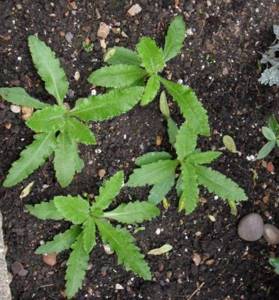
To speed up the germination process, you can cover the crops with plastic wrap. Shoots may appear in 2 weeks; throughout this period it will be necessary to maintain the level of humidity in the garden bed.
To protect the emerging seedlings, you can build a light shelter; film or spunbond will protect the tender seedlings from frost, sun and wind.
To prevent the plants from being too crowded, the seeds can be spread at a distance of 3-5 cm from each other when sowing. If the seedlings are too dense, they are thinned out after the third leaf appears.
Poppies grown from seeds usually bloom in their second or third year.
Vegetative propagation methods require quite careful care; poppy takes root in a new place quite difficult. Flowering is usually observed the next year after planting.
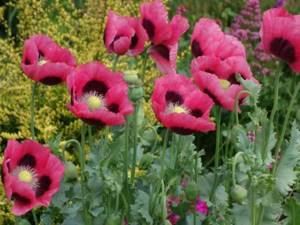
Three to five year old bushes are chosen for division. In this case, it is not recommended to completely dig up the bush; you only need to separate a fragment of the root from the side. Division can be done in early spring, before the buds appear, or in the fall, after flowering has ended. Care should be taken to preserve the fragile root system as much as possible.
The method of dividing the bush is advantageous in that the result is plants that are absolutely identical to the mother plant, preserving all the characteristics of the variety.
When propagating by lateral shoots, it is recommended to keep the cuttings before planting for 24 hours in a solution of root or any other root formation stimulant.

For planting, loose soil is prepared, moistened, the planted cuttings are covered with transparent caps, you can use plastic bottles of mineral water. After roots form, the plants are transplanted to a permanent location.
Reproduction
Perennial poppy is propagated by dividing the bush, cuttings, and seeds. Some species reproduce well by self-sowing. Seeds of perennial poppy are sown in July or August immediately in a permanent place, since the plant does not tolerate transplantation well. It is possible to grow through seedlings. The flowers will bloom next year.
Dividing the bush is carried out in the summer, after flowering, when the plant is at rest.
When cuttings, weak side shoots are taken, which are kept in a special disinfectant solution for 24 hours, and only then planted in the substrate. The cuttings are rooted in containers with loose and moist soil under a film. Cuttings are planted in open ground around mid-August.
Why perennial poppy does not bloom, what to do
The reasons may be different, firstly, very young plants spend all their energy on the growth of the rhizome. Usually in the second or third year of life the first flower stalks appear, one or two; only in the 3-4th year will flowering be lush.
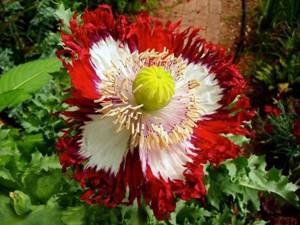
Lack of flowering can be observed due to the strong shading of the area.
Proper care plays an important role in the formation of buds; for example, the plant may suffer from too active loosening, which damages the root system.
What else you should know: Oriental poppy contains opium
When choosing poppy varieties for planting in the garden, you should keep in mind that some of them contain opioids, which are classified as narcotic substances.
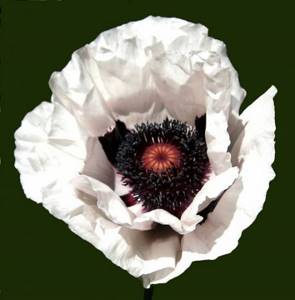
The law prohibits the cultivation of plant varieties containing opium. It is not difficult to identify prohibited varieties; they have a large seed pod. In decorative varieties it is small.
Do not forget that growing oriental poppies may result in an administrative fine if the number of bushes does not exceed 9 pieces. If there are 10 or more plants, the gardener may be prosecuted.

